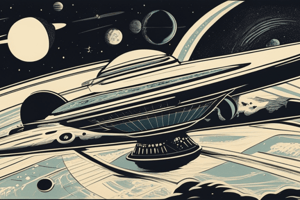Podcast
Questions and Answers
___ adalah planet yang terdekat dengan Matahari
___ adalah planet yang terdekat dengan Matahari
Mercury
Planet ___ dikenal sebagai planet berawan dengan atmosfer yang dominan terdiri dari hidrogen dan helium
Planet ___ dikenal sebagai planet berawan dengan atmosfer yang dominan terdiri dari hidrogen dan helium
Jupiter
___ dan Neptunus dijuluki sebagai Ice Giants karena dilapisi oleh metana, amonia, dan uap air yang membeku
___ dan Neptunus dijuluki sebagai Ice Giants karena dilapisi oleh metana, amonia, dan uap air yang membeku
Uranus
Kuiper Belt penuh dengan kerdil beku dan ___
Kuiper Belt penuh dengan kerdil beku dan ___
Planet-planet Merkurius, Venus, Bumi, dan Mars disebut sebagai Terran karena memiliki permukaan ___ yang terdiri dari mineral silikat
Planet-planet Merkurius, Venus, Bumi, dan Mars disebut sebagai Terran karena memiliki permukaan ___ yang terdiri dari mineral silikat
Neptunus adalah planet terjauh di Tata Surya dan berbatasan dengan ___ Cloud
Neptunus adalah planet terjauh di Tata Surya dan berbatasan dengan ___ Cloud
Meski memiliki komposisi dan karakteristik yang unik, semua planet di Tata Surya kita termasuk dalam keluarga pohon berawal dari _ _ atau _ awal, dilahirkan selama runtuhnya awan primordial debu dan gas kira-kira 4,5 miliar tahun yang lalu.
Meski memiliki komposisi dan karakteristik yang unik, semua planet di Tata Surya kita termasuk dalam keluarga pohon berawal dari _ _ atau _ awal, dilahirkan selama runtuhnya awan primordial debu dan gas kira-kira 4,5 miliar tahun yang lalu.
Pada umumnya, planet-planet di Tata Surya memiliki satelit-satelit yang juga dikenal sebagai _.
Pada umumnya, planet-planet di Tata Surya memiliki satelit-satelit yang juga dikenal sebagai _.
Jupiter memiliki tiga satelit yang cukup besar yaitu Ganymede, Callisto, dan Io, yang menyaingi dua bulan Mars, yaitu Phobos dan _.
Jupiter memiliki tiga satelit yang cukup besar yaitu Ganymede, Callisto, dan Io, yang menyaingi dua bulan Mars, yaitu Phobos dan _.
Penjelajahan teknologi telah memungkinkan manusia untuk mendapatkan wawasan yang mendalam tentang mekanisme yang mengatur _ _ kita di alam semesta.
Penjelajahan teknologi telah memungkinkan manusia untuk mendapatkan wawasan yang mendalam tentang mekanisme yang mengatur _ _ kita di alam semesta.
NASA Voyager 1 dan Voyager 2 terus melakukan perjalanan ke ruang antarbintang, setelah keluar dari batas Tata Surya, dengan demikian memperluas _ _ jangkauan manusia.
NASA Voyager 1 dan Voyager 2 terus melakukan perjalanan ke ruang antarbintang, setelah keluar dari batas Tata Surya, dengan demikian memperluas _ _ jangkauan manusia.
Setiap pengungkapan menawarkan wawasan baru tentang asal usul tempat tinggal kita yang unik, menerangi _ atas banyaknya wilayah yang belum terungkap penuh.
Setiap pengungkapan menawarkan wawasan baru tentang asal usul tempat tinggal kita yang unik, menerangi _ atas banyaknya wilayah yang belum terungkap penuh.
Flashcards are hidden until you start studying
Study Notes
Discovering the Wonders of the Solar System: Focus on Planets
The vast expanse of our celestial home, the Solar System, harbors an array of mysteries waiting to unfold beneath its brightly lit stage. As we venture through space and expand our understanding of this grand theater, let's shine a spotlight on those illuminating bodies we call Planets.
Planets, ranging from scorched deserts like Mercury to the blue and green oasis of Earth, share common threads: They orbit the Sun and inhabit spaces within varying distances governed by the fundamental laws of physics and chemistry. The Solar System consists of eight primary planets, which may seem insignificant compared to the numerous uncharted universes, yet each holds captivating details worthy of discovery.
Mercury, Venus, Earth, and Mars are defined as Terran (Earthlike) due to their solid surfaces composed predominantly of silicate minerals. Further outward, we encounter the Gas Giants — Jupiter and Saturn, which feature extensive atmospheres comprising molecular hydrogen and helium. Straddling the distance where sunlight barely penetrates, Uranus and Neptune emerge as the Ice Giants cloaked in frozen methane, ammonia, and water vapor.
Beyond the shores of Neptune dwells the Kuiper Belt, brimming with icy dwarfs and comets, leading to the ethereal Oort Cloud, containing trillions of icy bodies frozen in deep space.
The Solar System is peppered with satellite companions, such as Jupiter's Ganymede, Callisto, and Io, which rival Mars' two moons, Phobos and Deimos, in their numbers and contribute to the dance of celestial entities.
Despite their unique composition and characteristics, all planets in our Solar System belong to the family tree of rocky or gas beginnings, birthed during the collapse of a primordial cloud of dust and gas roughly 4.5 billion years ago.
Throughout the ages, humanity's curiosity has propelled technological advancements, enabling exploration and the acquisition of profound insights into the mechanisms governing our corner of the universe. The NASA Voyager 1 and Voyager 2 continue their journey into interstellar space, having exited the confines of the Solar System, thereby broadening the horizons of mankind's reach.
As we delve deeper into the mysteries concealed within our local cosmos, we breathe life into an ongoing dialogue between human imagination and scientific discovery. Each revelation offers new insight into the origins of our unique abode, shining a light upon the multitude of undiscovered realms teeming with potential.
Studying That Suits You
Use AI to generate personalized quizzes and flashcards to suit your learning preferences.




